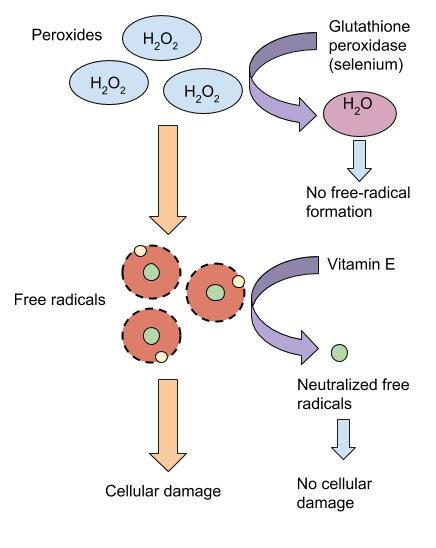11.10 – Selenium
Learning Objective
- Describe the role of Selenium in the body.
Selenium is a cofactor of enzymes that release active thyroid hormone in cells and therefore low levels can cause similar signs and symptoms as iodine deficiency. The other important function of selenium is as an antioxidant.
Around twenty-five, known proteins require selenium to function. Some are enzymes involved in detoxifying free radicals and include glutathione peroxidases and thioredoxin reductase. As an integral functioning part of these enzymes, selenium aids in the regeneration of glutathione and oxidized vitamin C. Selenium, as part of glutathione peroxidase, also protects lipids from free radicals, and, in doing so, spares vitamin E. This is just one example of how antioxidants work together to protect the body against free-radical induced damage. Other functions of selenium-containing proteins include protecting endothelial cells that line tissues, converting the inactive thyroid hormone to the active form in cells, and mediating inflammatory and immune system responses.
An updated review of selenium’s role in preventing cancer published in the Cochrane Database of Systematic Reviews concluded that “all of the high-quality randomized trials reported no effect of selenium on reducing the overall risk of cancer or risk of particular cancers, including the most investigated outcome – prostate cancer. Some trials unexpectedly suggested that selenium may increase risks of high-grade prostate cancer, type 2 diabetes, and dermatological abnormalities.”1 Additionally, this review states that there is no convincing evidence that selenium supplements reduce cancer risk.2
Because of its role as a lipid protector, selenium has been suspected to prevent cardiovascular disease. However, according to current knowledge, there is insufficient evidence to support any protective effects of selenium supplementation in cardiovascular prevention.3
1,2 Vinceti M. et al. Selenium for Preventing Cancer. Cochrane Database of Systematic Reviews. Updated January 29, 2018. Accessed June 30, 2019.
3 Benstoem C, Goetzenich A, Kraemer S, et al. Selenium and its supplementation in cardiovascular disease–what do we know?. Nutrients. 2015;7(5):3094–3118. DOI:10.3390/nu7053094. Accessed May 30, 2019.

Long Description:
The diagram illustrates the process of cellular damage caused by free radicals and its prevention by antioxidants. At the top left, three blue ovals labeled “H₂O₂,” represent peroxides. An orange arrow points downward from these peroxides to three red circles with black dashed outlines, labeled “Free radicals.” An adjacent orange arrow points down from these free radicals to a section labeled “Cellular damage.” To the right, a purple arrow labeled “Glutathione peroxidase (selenium)” points rightward to a pink oval labeled “H₂O,” which connects downward with the blue text, “No free-radical formation.” Below, purple text labeled “Vitamin E” has an accompanying arrow pointing rightwards to a small green circle, leading downward to text reading “Neutralized free radicals” and “No cellular damage.”
Transcribed Text:
Peroxides
H₂O₂
Free radicals
Cellular damage
Glutathione peroxidase (selenium)
H₂O
No free-radical formation
Vitamin E
Neutralized free radicals
No cellular damage
Dietary Reference Intakes for Selenium
The IOM has set the RDAs for selenium based on the amount required to maximize the activity of glutathione peroxidases found in blood plasma. The RDAs for different age groups are listed in Table 11.10.1.
| Age Group | R.D.A. Males and Females (micrograms per day) | U.L. |
|---|---|---|
| Infants (0–6 months) | 15* | 45 |
| Infants (7–12 months) | 20* | 65 |
| Children (1–3 years) | 20 | 90 |
| Children (4–8 years) | 30 | 150 |
| Children (9–13 years) | 40 | 280 |
| Adolescents (14–18 years) | 55 | 400 |
| Adults (> 19 years) | 55 | 400 |
Selenium at doses several thousand times the RDA can cause acute toxicity, and when ingested in gram quantities can be fatal. Chronic exposure to foods grown in soils containing high levels of selenium (significantly above the UL) can cause brittle hair and nails, gastrointestinal discomfort, skin rashes, halitosis, fatigue, and irritability. The IOM has set the UL for selenium for adults at 400 micrograms per day.
| Food | Serving | Selenium (micrograms) | Percent Daily Value |
|---|---|---|---|
| Brazil nuts | 1 oz. | 544 | 777 |
| Shrimp | 3 oz. | 34 | 49 |
| Crabmeat | 3 oz. | 41 | 59 |
| Ricotta cheese | 1 c. | 41 | 59 |
| Salmon | 3 oz. | 40 | 57 |
| Pork | 3 oz. | 35 | 50 |
| Ground beef | 3 oz. | 18 | 26 |
| Round steak | 3 oz. | 28.5 | 41 |
| Beef liver | 3 oz. | 28 | 40 |
| Chicken | 3 oz. | 13 | 19 |
| Whole-wheat bread | 2 slices | 23 | 33 |
| Couscous | 1 c. | 43 | 61 |
| Barley, cooked | 1 c. | 13.5 | 19 |
| Milk, low-fat | 1 c. | 8 | 11 |
| Walnuts, black | 1 oz. | 5 | 7 |
Source: US Department of Agriculture, Agricultural Research Service. 2010. USDA National Nutrient Database for Standard Reference, Release 23.
Contributors
University of Hawai’i at Mānoa Food Science and Human Nutrition Program: Allison Calabrese, Cheryl Gibby, Billy Meinke, Marie Kainoa Fialkowski Revilla, and Alan Titchenal

